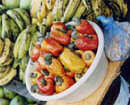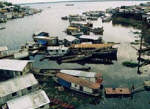Turning to peer through a shop window, I was surprised to see that here you could buy anything from the latest computers, cameras and television sets. Joici explains that her brother works at the Panasonic factory where he packages electrical goods ready for distribution throughout Brazil and neighbouring countries. Manaus, known today as a “zona franca” – (duty free zone) was a government initiative during the early 90’s attempting to encourage foreign commercial interests and tourism to the region. Successful, this enterprise saw electronic giants such as IBM, Panasonic, Sony and Canon base their headquarters here providing badly needed employment opportunities and a huge economic boost to the region.
|
![]()
As the midday heat intensified and my new shirt became saturated from perspiration, a little juice store enticed us to quench our thirst and replenish some lost fluid. The little bar was stocked with every fruit imaginable, including some exotic pulps unique to this part of the world. Bananas were an amazing red in colour and having only ever eaten the cashew as a nut, I never imagined its fruit could taste so exquisite. Popular with the locals was combination of juice and guarana, a natural stimulant powder crushed from the seed of a native berry. “It’s good, huh! Makes you strong and gives you lots of energy,” said Dylla.
The sisters bade me farewell, to return home. School for them begins at 4pm. Joici said that here in Brazil most people had to work during the day and the only way they could study was to go at night. During the day, her and Dylla sewed children’s clothing for a friend of a neighbour and on occasional weekends served drinks at a bar close to her home. Both girls had lived alone since their mother died early last year. They extended their hospitality and asked me if I would come to their home for lunch on Sunday. I gladly accepted their friendly invitation and with a smile they told me that they would pick me up from my hotel. As the sisters headed to the bus stop, I removed and unfolded a map from my back pocket to direct me back to my hotel.
My hotel was a family run, art deco building, two blocks back from the river foreshore. Entering the main courtyard I felt I was in a scene from Casablanca. A rickety old fan spun aimlessly from the ceiling above the manager who greeted me with a friendly smile as he wiped bubbles of perspiration from his brow. I headed straight to my room, where my only relief from this stifling heat would be a cold shower. I would never have dreamed that cold water could ever feel so soothing and relaxing.
After my refreshing shower I climbed to the terrace rooftop to hang my washing. Here I was treated to a magnificent view of this amazing natural wonder. As I stood in awe, no words could do justice nor describe the enormity and splendour of the river. To the people of this immense region larger than Western Europe, this river is their lifeblood, home, means of transport and playground. The 6000km of river and its 1000 tributaries form a network of watery highways with interconnecting roads into a region seemingly impenetrable by conventional wheels. Fruitless attempts to build roads have resulted in them being reclaimed by the rainforest just as quickly as they are built.
Manaus is the hub of the river transport and used by its people to ferry passengers, merchandise and stock to distant towns and villages. At the port, boats of varying sizes and comforts display signs publicizing their destination, date and time of sailing. Hammock for a bed, here you can catch a boat to Colombia, Venezuela, Peru, Bolivia, or four days down stream to Belém, on the Atlantic coast.
|
![]()
Feeling drawn towards its magical waters I took a stroll along the walled embankment of rua “dos Bares” (two bars). Suddenly I tripped opposite the Mercado “Adolfo Lisboa” as I was admiring the iron structure, rumoured to have been designed by Eiffel himself as a miniature replica of the now non-existent Les Halle in Paris. Re-establishing my footing, I noticed a series of wires and thin cables, which on following led me toward a street light pole. Retracing them across the road, I noticed the wires continued over the embankment and into the water toward a collection of small riverboats nestled close together near the riverbank.

